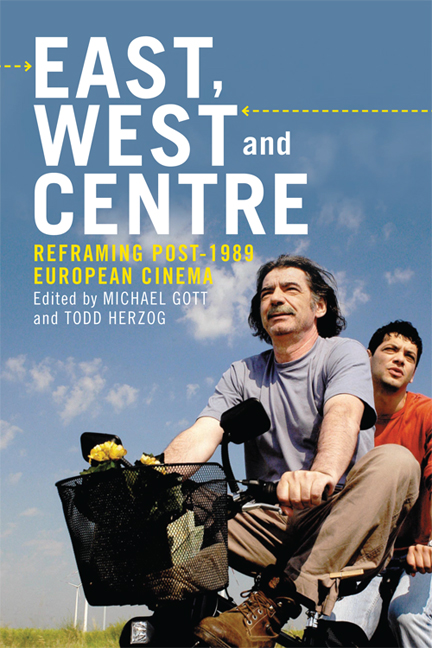Book contents
- Frontmatter
- Contents
- List of Figures
- Notes on Contributors
- Acknowledgements
- Introduction: East, West and Centre: ‘Mapping Post-1989 European Cinema’
- Part I Redrawing the Lines: De/Recentring Europe
- 1 The Berlin Wall Revisited: Reframing Historical Space between East and West in Cynthia Beatts's Cycling the Frame (1988), The Invisible Frame (2009) and Bartosz Konopka's Rabbit à la Berlin (2009)
- 2 Changing Sides: East/West Travesties in Lionel Baier's Comme des voleurs (à l'est)
- 3 Dubbing and Doubling Over: The Disorientation of France in the Films of Michael Haneke and Krzysztof Kieślowski
- 4 Challenging the East–West Divide in Ulrich Seidl's Import Export (2007)
- 5 Fatih Akın's Filmic Visions of a New Europe: Spatial and Aural Constructions of Europe in Im Juli/In July (2000
- 6 Salami Aleikum – The ‘Near East’ Meets the ‘Middle East’ in Europe
- 7 Cinematic Fairy Tales of Female Mobility in Post-Wall Europe: Hanna v. Mona
- Part II Border Spaces, Eastern Margins and Eastern Markets: Belonging and the Road to/from Europe
- Part III Spectres of the East
- Notes
- Bibliography
- Index
6 - Salami Aleikum – The ‘Near East’ Meets the ‘Middle East’ in Europe
from Part I - Redrawing the Lines: De/Recentring Europe
Published online by Cambridge University Press: 05 September 2016
- Frontmatter
- Contents
- List of Figures
- Notes on Contributors
- Acknowledgements
- Introduction: East, West and Centre: ‘Mapping Post-1989 European Cinema’
- Part I Redrawing the Lines: De/Recentring Europe
- 1 The Berlin Wall Revisited: Reframing Historical Space between East and West in Cynthia Beatts's Cycling the Frame (1988), The Invisible Frame (2009) and Bartosz Konopka's Rabbit à la Berlin (2009)
- 2 Changing Sides: East/West Travesties in Lionel Baier's Comme des voleurs (à l'est)
- 3 Dubbing and Doubling Over: The Disorientation of France in the Films of Michael Haneke and Krzysztof Kieślowski
- 4 Challenging the East–West Divide in Ulrich Seidl's Import Export (2007)
- 5 Fatih Akın's Filmic Visions of a New Europe: Spatial and Aural Constructions of Europe in Im Juli/In July (2000
- 6 Salami Aleikum – The ‘Near East’ Meets the ‘Middle East’ in Europe
- 7 Cinematic Fairy Tales of Female Mobility in Post-Wall Europe: Hanna v. Mona
- Part II Border Spaces, Eastern Margins and Eastern Markets: Belonging and the Road to/from Europe
- Part III Spectres of the East
- Notes
- Bibliography
- Index
Summary
Intro/Easts
This chapter will analyse the feature film Salami Aleikum (2009, Germany) by the Iranian-born German director, Ali Samadi Ahadi, as a postcolonial commentary on the reinvention of the ‘near’ and ‘middle’ east in mainstream German society. Ahadi plays with the idea that present-day Germany has two political entities that can be referred to as ‘der Nahe Osten’ (literally the ‘near east’; in English the ‘Middle East’). In this romantic comedy, images of many ‘easts’ serve to complicate further the German-centric East/West divide by referencing a confluence of stereotypes and homogenisations that conflate Arab and Persian cultures, the Far and the Middle East, as well as the much closer, but seemingly no less estranged, regions within and beyond Germany's ‘east’, that is, Poland and the former communist GDR (German Democratic Republic). In doing so, this seemingly broad and unambitious comedy reveals itself to be a self-reflexive metapoetic commentary on narrative, identity and myth-making.
Postcolonial Discourse
In Salami Aleikum the encounter between East Germans and Persian immigrants serves as a vehicle to expose stereotypes and xenophobia, colonial attitudes, and the willing exploitation of exoticism at play in many societies. Rather than problematising alterity, however, similarities between these East Germans and Persians are uncovered after the initial clash of the two representatives from very different ‘easts’, as they come to understand that each has lost their respective homeland (Heimat). They bond by allowing one another to reinvent themselves as an exotic ‘other’.
The stereotypical families used to exemplify this rapprochement are the East German Bergheims with their adult daughter, Ana, and the Persian migrants to West Germany, the Taheris, whose son, Mohsen, is in his late twenties. It is the offspring of both families who instigate the departure from a diasporic mentality which feeds off the invention of a glorified past. Ana's and Mohsen's emancipation – achieved by refusing to adopt this oldstyle mentality – serves as a vehicle for change and thus breaks the vicious circle their parents have manoeuvred themselves into by clamouring for their lost past and therefore living in, and surrounded by, relics of that past.
- Type
- Chapter
- Information
- East, West and CentreReframing post-1989 European Cinema, pp. 95 - 108Publisher: Edinburgh University PressPrint publication year: 2014

